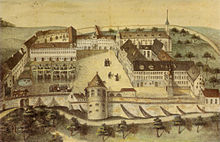Elchingen Abbey
Imperial Abbey of Elchingen Reichsabtei Elchingen | |||||||||
|---|---|---|---|---|---|---|---|---|---|
| 1128–1802 | |||||||||
Secularised to Bavaria | 1802 | ||||||||
| |||||||||
Elchingen Abbey (
For much of its history, Elchingen was one of the 40-odd self-ruling imperial abbeys of the Holy Roman Empire and, as such, was a virtually independent state that contained several villages aside from the monastery itself. At the time of its secularisation in 1802, the abbey covered 112 square kilometers and had 4000-4200 subjects.[1]
History

Dedicated to the
Like all the other imperial abbeys, Elchingen lost its independence in the course of the
On October 17, 1805 (25 Vendémiaire, Year 14), at 2 o'clock in the afternoon, Napoleon wrote from the Abbey of Elchingen to Prince Murat: " ... It seems to me that you should have slept where the 9th light is, so as to be able, at daybreak, to follow the enemy and outrun him"
In 1921 the Missionary Oblates of Mary Immaculate settled on the site.
References
Bibliography
- Brenner, Bernhard, 2003. Das ehemalige Reichsstift Elchingen/Oberelchingen. In: Klosterland Bayerisch Schwaben Werner Schiedermair (ed.), pp216–219. Lindenberg Fink. ISBN 3-89870-127-1.
- Correspondance de Napoléon, t.11, letters 9386; Correspondance générale de Napoléon, t.5, letter 11007.
- Dirr, Albert, 1926. Die Reichsabtei Elchingen von der Mitte des 15. bis zur Mitte des 16. Jahrhunderts. Augsburg (also dissertation, University of Munich 1925)
- Konrad, Anton H., 1965. Die Reichsabtei Elchingen. Ihr Bild im Wandel der Jahrhunderte. Weissenhorn: Konrad.
- Kramer, Ferdinand Kramer, 1991. "Wissenschaft und Streben nach 'Wahrer Aufklärung'. Ein Beitrag zur Aufklärung im ostschwäbischen Benediktinerkloster Elchingen", in: Zeitschrift für bayerische Landesgeschichte, 54 / 1991, 1:269-286 (ISSN 0044-2364)
External links
- (in German) Records of Elchingen Abbey
- (in German) Klöster in Bayern


